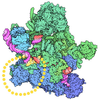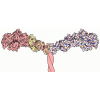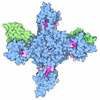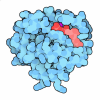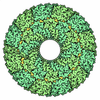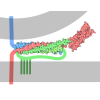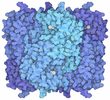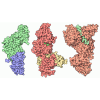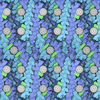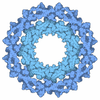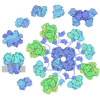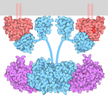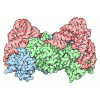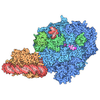[English] 日本語
 Yorodumi
Yorodumi- PDB-9b2z: Actin-bound Legionella pneumophila AMPylase LnaB with AMPylated c... -
+ Open data
Open data
- Basic information
Basic information
| Entry | Database: PDB / ID: 9b2z | |||||||||
|---|---|---|---|---|---|---|---|---|---|---|
| Title | Actin-bound Legionella pneumophila AMPylase LnaB with AMPylated catalytic histidine | |||||||||
 Components Components |
| |||||||||
 Keywords Keywords | TRANSFERASE / AMPylase / antitoxin / actin / ubiquitin | |||||||||
| Function / homology |  Function and homology information Function and homology informationpositive regulation of norepinephrine uptake / bBAF complex / cellular response to cytochalasin B / npBAF complex / nBAF complex / brahma complex / regulation of transepithelial transport / Formation of annular gap junctions / Formation of the dystrophin-glycoprotein complex (DGC) / morphogenesis of a polarized epithelium ...positive regulation of norepinephrine uptake / bBAF complex / cellular response to cytochalasin B / npBAF complex / nBAF complex / brahma complex / regulation of transepithelial transport / Formation of annular gap junctions / Formation of the dystrophin-glycoprotein complex (DGC) / morphogenesis of a polarized epithelium / structural constituent of postsynaptic actin cytoskeleton / Gap junction degradation / GBAF complex / Folding of actin by CCT/TriC / regulation of G0 to G1 transition / protein localization to adherens junction / Cell-extracellular matrix interactions / dense body / Tat protein binding / postsynaptic actin cytoskeleton / Prefoldin mediated transfer of substrate to CCT/TriC / RSC-type complex / regulation of double-strand break repair / regulation of nucleotide-excision repair / Adherens junctions interactions / RHOF GTPase cycle / adherens junction assembly / apical protein localization / Sensory processing of sound by outer hair cells of the cochlea / Interaction between L1 and Ankyrins / tight junction / SWI/SNF complex / regulation of mitotic metaphase/anaphase transition / Sensory processing of sound by inner hair cells of the cochlea / positive regulation of T cell differentiation / apical junction complex / positive regulation of double-strand break repair / maintenance of blood-brain barrier / regulation of norepinephrine uptake / nitric-oxide synthase binding / transporter regulator activity / cortical cytoskeleton / NuA4 histone acetyltransferase complex / establishment or maintenance of cell polarity / positive regulation of stem cell population maintenance / Recycling pathway of L1 / Regulation of MITF-M-dependent genes involved in pigmentation / brush border / regulation of G1/S transition of mitotic cell cycle / EPH-ephrin mediated repulsion of cells / negative regulation of cell differentiation / kinesin binding / RHO GTPases Activate WASPs and WAVEs / regulation of synaptic vesicle endocytosis / positive regulation of myoblast differentiation / RHO GTPases activate IQGAPs / regulation of protein localization to plasma membrane / positive regulation of double-strand break repair via homologous recombination / EPHB-mediated forward signaling / cytoskeleton organization / substantia nigra development / axonogenesis / calyx of Held / nitric-oxide synthase regulator activity / Translocation of SLC2A4 (GLUT4) to the plasma membrane / FCGR3A-mediated phagocytosis / actin filament / adherens junction / Regulation of endogenous retroelements by Piwi-interacting RNAs (piRNAs) / positive regulation of cell differentiation / cell motility / RHO GTPases Activate Formins / Signaling by high-kinase activity BRAF mutants / MAP2K and MAPK activation / DNA Damage Recognition in GG-NER / Regulation of actin dynamics for phagocytic cup formation / B-WICH complex positively regulates rRNA expression / kinetochore / structural constituent of cytoskeleton / Hydrolases; Acting on acid anhydrides; Acting on acid anhydrides to facilitate cellular and subcellular movement / VEGFA-VEGFR2 Pathway / platelet aggregation / Schaffer collateral - CA1 synapse / tau protein binding / nuclear matrix / cytoplasmic ribonucleoprotein granule / Signaling by RAF1 mutants / Signaling by moderate kinase activity BRAF mutants / Paradoxical activation of RAF signaling by kinase inactive BRAF / Signaling downstream of RAS mutants / cell-cell junction / Signaling by BRAF and RAF1 fusions / UCH proteinases / nucleosome / presynapse / lamellipodium / actin cytoskeleton / Clathrin-mediated endocytosis / HATs acetylate histones / Factors involved in megakaryocyte development and platelet production Similarity search - Function | |||||||||
| Biological species |  Legionella pneumophila subsp. pneumophila str. Philadelphia 1 (bacteria) Legionella pneumophila subsp. pneumophila str. Philadelphia 1 (bacteria) Homo sapiens (human) Homo sapiens (human) | |||||||||
| Method | ELECTRON MICROSCOPY / single particle reconstruction / cryo EM / Resolution: 2.83 Å | |||||||||
 Authors Authors | Zhang, Z. / Das, C. | |||||||||
| Funding support |  United States, 2items United States, 2items
| |||||||||
 Citation Citation |  Journal: J Mol Biol / Year: 2025 Journal: J Mol Biol / Year: 2025Title: Cryo-EM Detection of AMPylated Histidine Implies Covalent Catalysis in AMPylation Mediated by a Bacterial Effector. Authors: Zhengrui Zhang / Rishi Patel / Zhao-Qing Luo / Chittaranjan Das /  Abstract: AMPylation is a post-translational modification (PTM) whereby adenosine monophosphate (AMP) from adenosine triphosphate (ATP) is transferred onto protein hydroxyl groups of serine, threonine, or ...AMPylation is a post-translational modification (PTM) whereby adenosine monophosphate (AMP) from adenosine triphosphate (ATP) is transferred onto protein hydroxyl groups of serine, threonine, or tyrosine. Recently, an actin-dependent AMPylase namely LnaB from the bacterial pathogen Legionella pneumophila was found to AMPylate phosphate groups of phosphoribosylated ubiquitin and Src family kinases. LnaB represents an evolutionarily distinct family of AMPylases with conserved active site Ser-His-Glu residues. Here, we capture the structure of the LnaB-actin complex in a putative intermediate state via single-particle cryogenic electron microscopy (cryo-EM) and find that the catalytic histidine of LnaB is covalently attached to AMP through a phosphoramidate linkage at the Nδ1 atom. This observation provides direct structural evidence of histidine AMPylation as a PTM and implies the possibility of covalent catalysis in LnaB-mediated AMPylation, a mechanism distinct from known AMPylases. Subsequent biochemical studies confirm the observed AMP binding site and provide additional insights into the catalytic properties of LnaB. Together, our work highlights the power of cryo-EM in capturing labile PTMs and transient species during enzymatic reactions, while opening new avenues of mechanistic investigation into the LnaB family. | |||||||||
| History |
|
- Structure visualization
Structure visualization
| Structure viewer | Molecule:  Molmil Molmil Jmol/JSmol Jmol/JSmol |
|---|
- Downloads & links
Downloads & links
- Download
Download
| PDBx/mmCIF format |  9b2z.cif.gz 9b2z.cif.gz | 143.5 KB | Display |  PDBx/mmCIF format PDBx/mmCIF format |
|---|---|---|---|---|
| PDB format |  pdb9b2z.ent.gz pdb9b2z.ent.gz | 104.3 KB | Display |  PDB format PDB format |
| PDBx/mmJSON format |  9b2z.json.gz 9b2z.json.gz | Tree view |  PDBx/mmJSON format PDBx/mmJSON format | |
| Others |  Other downloads Other downloads |
-Validation report
| Summary document |  9b2z_validation.pdf.gz 9b2z_validation.pdf.gz | 1.3 MB | Display |  wwPDB validaton report wwPDB validaton report |
|---|---|---|---|---|
| Full document |  9b2z_full_validation.pdf.gz 9b2z_full_validation.pdf.gz | 1.3 MB | Display | |
| Data in XML |  9b2z_validation.xml.gz 9b2z_validation.xml.gz | 36.4 KB | Display | |
| Data in CIF |  9b2z_validation.cif.gz 9b2z_validation.cif.gz | 52.4 KB | Display | |
| Arichive directory |  https://data.pdbj.org/pub/pdb/validation_reports/b2/9b2z https://data.pdbj.org/pub/pdb/validation_reports/b2/9b2z ftp://data.pdbj.org/pub/pdb/validation_reports/b2/9b2z ftp://data.pdbj.org/pub/pdb/validation_reports/b2/9b2z | HTTPS FTP |
-Related structure data
| Related structure data |  44118MC M: map data used to model this data C: citing same article ( |
|---|---|
| Similar structure data | Similarity search - Function & homology  F&H Search F&H Search |
- Links
Links
- Assembly
Assembly
| Deposited unit | 
|
|---|---|
| 1 |
|
- Components
Components
-Protein , 2 types, 2 molecules AB
| #1: Protein | Mass: 58642.035 Da / Num. of mol.: 1 / Mutation: S261A Source method: isolated from a genetically manipulated source Source: (gene. exp.)  Legionella pneumophila subsp. pneumophila str. Philadelphia 1 (bacteria) Legionella pneumophila subsp. pneumophila str. Philadelphia 1 (bacteria)Gene: lpg2527 / Production host:  |
|---|---|
| #2: Protein | Mass: 41782.660 Da / Num. of mol.: 1 / Source method: isolated from a natural source / Source: (natural)  Homo sapiens (human) / References: UniProt: P60709 Homo sapiens (human) / References: UniProt: P60709 |
-Non-polymers , 4 types, 4 molecules 






| #3: Chemical | ChemComp-AMP / |
|---|---|
| #4: Chemical | ChemComp-CA / |
| #5: Chemical | ChemComp-LAB / |
| #6: Chemical | ChemComp-ATP / |
-Details
| Has ligand of interest | Y |
|---|---|
| Has protein modification | Y |
-Experimental details
-Experiment
| Experiment | Method: ELECTRON MICROSCOPY |
|---|---|
| EM experiment | Aggregation state: PARTICLE / 3D reconstruction method: single particle reconstruction |
- Sample preparation
Sample preparation
| Component |
| ||||||||||||||||||||||||
|---|---|---|---|---|---|---|---|---|---|---|---|---|---|---|---|---|---|---|---|---|---|---|---|---|---|
| Source (natural) |
| ||||||||||||||||||||||||
| Source (recombinant) | Organism:  | ||||||||||||||||||||||||
| Buffer solution | pH: 8 | ||||||||||||||||||||||||
| Specimen | Conc.: 1 mg/ml / Embedding applied: NO / Shadowing applied: NO / Staining applied: NO / Vitrification applied: YES | ||||||||||||||||||||||||
| Vitrification | Cryogen name: ETHANE |
- Electron microscopy imaging
Electron microscopy imaging
| Experimental equipment |  Model: Titan Krios / Image courtesy: FEI Company |
|---|---|
| Microscopy | Model: TFS KRIOS |
| Electron gun | Electron source:  FIELD EMISSION GUN / Accelerating voltage: 300 kV / Illumination mode: FLOOD BEAM FIELD EMISSION GUN / Accelerating voltage: 300 kV / Illumination mode: FLOOD BEAM |
| Electron lens | Mode: BRIGHT FIELD / Nominal defocus max: 2000 nm / Nominal defocus min: 600 nm / Cs: 2.7 mm |
| Specimen holder | Cryogen: NITROGEN / Specimen holder model: FEI TITAN KRIOS AUTOGRID HOLDER |
| Image recording | Electron dose: 59.5 e/Å2 / Film or detector model: GATAN K3 (6k x 4k) |
- Processing
Processing
| EM software | Name: PHENIX / Version: 1.18.2_3874: / Category: model refinement | ||||||||||||||||||||||||
|---|---|---|---|---|---|---|---|---|---|---|---|---|---|---|---|---|---|---|---|---|---|---|---|---|---|
| CTF correction | Type: PHASE FLIPPING AND AMPLITUDE CORRECTION | ||||||||||||||||||||||||
| 3D reconstruction | Resolution: 2.83 Å / Resolution method: FSC 0.143 CUT-OFF / Num. of particles: 536510 / Symmetry type: POINT | ||||||||||||||||||||||||
| Refine LS restraints |
|
 Movie
Movie Controller
Controller


 PDBj
PDBj

